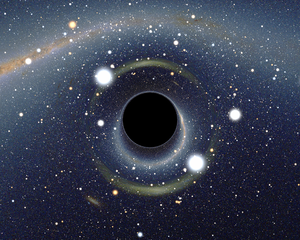Bức xạ Hawking Chú thích | Trình đơn chuyển hướngtăng chất lượng bản dịch1999PhyEs..12..346Rastro-ph/021224910.4006/1.3025389“A conversation with Dr. Stephen Hawking & Lucy Hawking”Bản gốc“'40 Years of Black Hole Thermodynamics' in Jerusalem”Recent Developments in Intelligent Nature-Inspired Computing2002PhRvD..65e6010Ghep-ph/010621910.1103/PhysRevD.65.0560102001PhRvL..87p1602D11690198hep-ph/010629510.1103/PhysRevLett.87.161602“The case for mini black holes”“Stephen Hawkings 50 bet on the world the universe and the God particle”
Lỗ đenLý thuyết trường lượng tửStephen HawkingGiả thuyết thiên văn học
vật lýStephen HawkingJacob BekensteinentropyMoskvaYakov Zeldovichnguyên lý bất địnhquay tròn đen lỗHố đen siêu nhỏNASAKính thiên văn vũ trụ Fermihố đen nguyên thủykích thước lớnCERNLarge Hadron Collider
Bức xạ Hawking
Buớc tưới chuyển hướng
Bước tới tìm kiếm
| Bài này là một bản dịch thô từ bản tiếng Anh và dịch sai rất nhiều ý. Đây có thể là kết quả của máy tính hoặc của người chưa thông thạo dịch thuật. Xin hãy giúp tăng chất lượng bản dịch. |

Hình ảnh mô phỏng một lỗ đen (trung tâm) ở phía trước Mây Magellanic Lớn. Lưu ý hiệu ứng gravitational lens, tạo ra hai tiêu điểm mở rộng nhưng rất méo mó của nó. Ở phía trên cùng, đĩa Dải Ngân hà xuất hiện biến dạng thành một đường cung
Hawking radiation, còn được gọi là Hawking–Zel'dovich radiation,[1] là bức xạ của vật thể đen được dự đoán sẽ được phát ra bởi các lỗ đen, do hiệu ứng lượng tử gần chân trời sự kiện. Nó được đặt tên theo nhà vật lý Stephen Hawking, người đã cung cấp lý luận lý thuyết cho sự tồn tại của nó vào năm 1974 [2] và đôi khi cũng sau Jacob Bekenstein, người tiên đoán rằng các hố đen nên có một entropy[3]
Tác phẩm của Hawking sau chuyến thăm Moskva năm 1973, nơi mà các nhà khoa học Liên Xô Yakov Zeldovich và Alexei Starobinsky đã cho ông thấy rằng, theo cơ học lượng tử nguyên lý bất định, quay tròn đen lỗ tạo ra và phát ra các hạt[4] Bức xạ Hawking làm giảm khối lượng và năng lượng của các hố đen và do đó được biết đến như là sự bốc hơi lỗ đen. Vì lý do này, các lỗ đen không đạt được khối lượng thông qua các cách khác sẽ co lại và cuối cùng biến mất. Hố đen siêu nhỏ được dự đoán là phát ra các bức xạ lớn hơn các hố đen lớn hơn nên co lại và tiêu tan nhanh hơn[5]
Vào tháng 6 năm 2008 NASA cho ra đời Kính thiên văn vũ trụ Fermi, tìm kiếm các tia gamma mong đợi từ sự bốc hơi hố đen nguyên thủy. Trong trường hợp các giả thuyết kích thước lớn là đúng, CERN Large Hadron Collider có thể tạo ra các hố đen nhỏ và quan sát sự bốc hơi của chúng. Không có lỗ đen nào như vậy đã từng được quan sát tại CERN[6][7][8][9]
Chú thích |
^ Rabinowitz, Mario (2000). “Gravitational Tunneling Radiation”. Physics Essays 12 (2): 346–357. Bibcode:1999PhyEs..12..346R. arXiv:astro-ph/0212249. doi:10.4006/1.3025389.
^ Rose, Charlie. “A conversation with Dr. Stephen Hawking & Lucy Hawking”. charlierose.com. Bản gốc lưu trữ ngày 29 tháng 3 năm 2013.
^ Levi Julian, Hana (ngày 3 tháng 9 năm 2012). “'40 Years of Black Hole Thermodynamics' in Jerusalem”. Arutz Sheva. Truy cập ngày 8 tháng 9 năm 2012.
^ Hawking, Stephen (1988). A Brief History of Time. Bantam Books. ISBN 0-553-38016-8.
^ Srikanta, Patnaik (ngày 9 tháng 3 năm 2017). Recent Developments in Intelligent Nature-Inspired Computing (bằng tiếng Anh). IGI Global. ISBN 9781522523239.
^ Giddings, S.; Thomas, S. (2002). “High energy colliders as black hole factories: The end of short distance physics”. Physical Review D 65 (5): 056010. Bibcode:2002PhRvD..65e6010G. arXiv:hep-ph/0106219. doi:10.1103/PhysRevD.65.056010.
^ Dimopoulos, S.; Landsberg, G. (2001). “Black Holes at the Large Hadron Collider”. Physical Review Letters 87 (16): 161602. Bibcode:2001PhRvL..87p1602D. PMID 11690198. arXiv:hep-ph/0106295. doi:10.1103/PhysRevLett.87.161602.
^ “The case for mini black holes”. CERN courier. Tháng 11 năm 2004.
^ Henderson, Mark (ngày 9 tháng 9 năm 2008). “Stephen Hawkings 50 bet on the world the universe and the God particle”. The Times (London). Truy cập ngày 4 tháng 5 năm 2010.
Thể loại:
- Lỗ đen
- Lý thuyết trường lượng tử
- Stephen Hawking
- Giả thuyết thiên văn học
(window.RLQ=window.RLQ||[]).push(function()mw.config.set("wgPageParseReport":"limitreport":"cputime":"0.160","walltime":"0.209","ppvisitednodes":"value":421,"limit":1000000,"ppgeneratednodes":"value":0,"limit":1500000,"postexpandincludesize":"value":19666,"limit":2097152,"templateargumentsize":"value":81,"limit":2097152,"expansiondepth":"value":7,"limit":40,"expensivefunctioncount":"value":0,"limit":500,"unstrip-depth":"value":0,"limit":20,"unstrip-size":"value":11376,"limit":5000000,"entityaccesscount":"value":0,"limit":400,"timingprofile":["100.00% 181.640 1 -total"," 57.00% 103.543 1 Bản_mẫu:Tham_khảo"," 32.10% 58.315 1 Bản_mẫu:Dịch_máy"," 28.87% 52.438 1 Bản_mẫu:Hộp_thông_báo"," 23.47% 42.631 3 Bản_mẫu:Cite_journal"," 6.91% 12.545 2 Bản_mẫu:Chú_thích_báo"," 6.46% 11.728 2 Bản_mẫu:Chú_thích_sách"," 6.33% 11.502 2 Bản_mẫu:Chú_thích_web"," 1.38% 2.503 1 Bản_mẫu:Column-width"],"scribunto":"limitreport-timeusage":"value":"0.072","limit":"10.000","limitreport-memusage":"value":2556490,"limit":52428800,"cachereport":"origin":"mw1319","timestamp":"20190409141017","ttl":2592000,"transientcontent":false););"@context":"https://schema.org","@type":"Article","name":"Bu1ee9c xu1ea1 Hawking","url":"https://vi.wikipedia.org/wiki/B%E1%BB%A9c_x%E1%BA%A1_Hawking","sameAs":"http://www.wikidata.org/entity/Q497396","mainEntity":"http://www.wikidata.org/entity/Q497396","author":"@type":"Organization","name":"Nhu1eefng ngu01b0u1eddi u0111u00f3ng gu00f3p vu00e0o cu00e1c du1ef1 u00e1n Wikimedia","publisher":"@type":"Organization","name":"Wikimedia Foundation, Inc.","logo":"@type":"ImageObject","url":"https://www.wikimedia.org/static/images/wmf-hor-googpub.png","datePublished":"2018-01-18T20:15:02Z","dateModified":"2019-03-01T15:28:53Z","image":"https://upload.wikimedia.org/wikipedia/commons/5/5e/BH_LMC.png"(window.RLQ=window.RLQ||[]).push(function()mw.config.set("wgBackendResponseTime":141,"wgHostname":"mw1273"););